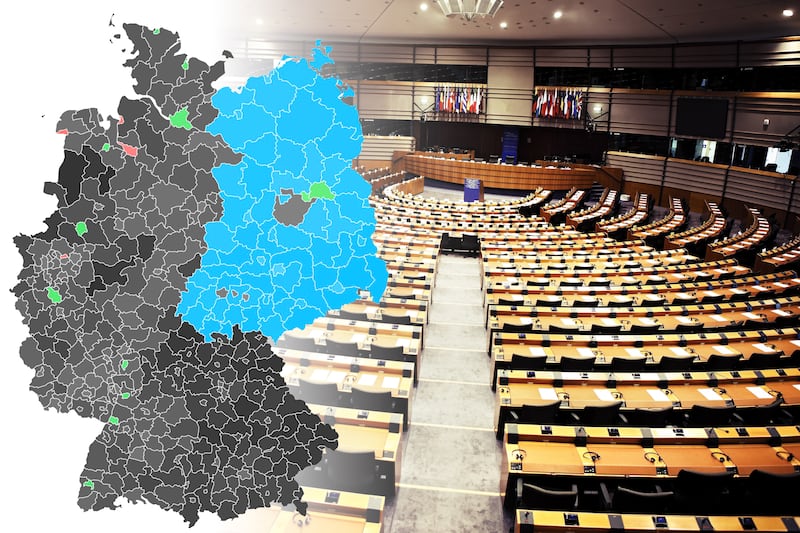Germany is not France. We learned that on Monday morning when a spokesman for chancellor Olaf Scholz insisted that – unlike French president Emmanuel Macron – the German leader would not respond to a European poll slump with a snap general election.
That prompted many here to ask: why not? With a historic third-place result of just 14 per cent, Sunday was not just another election disaster for the ruling Social Democratic Party (SPD) of Scholz.
Three years after the SPD, Greens and liberal Free Democratic Party (FDP) secured a combined 52 per cent of the vote, they now have just 31 per cent support. And this with a record election turnout of 64 per cent.
On a sunny Sunday, rather than escape to the beach or the park, German voters went out of their way to express no confidence in the so-called traffic light coalition. Newspapers on Monday morning carried a striking – and stark – political map of Germany in 2024. The Berlin coalition colours – red, green and yellow – are almost nowhere to be seen. Instead, with staggering clarity, we can see the old West and East Germany once more.
In western regions, the black of the centre-right Christian Democratic Union (CDU) and its Bavarian CSU allies mopped up support to finish first on 30 per cent. Election wins in the former territory of East Germany, meanwhile, almost exclusively went to the Alternative für Deutschland (AfD).

Nationwide, the far-right party finished in second place with nearly 16 per cent. In eastern regions, it topped the poll with more than 30 per cent support, including in three states of Brandenburg, Thuringia and Saxony.
This matters because voters here are, next September, likely to cast their votes in the same way when they choose new state parliaments. The AfD result is even more remarkable given how its lead candidates faced allegations of Russian bribes, Chinese spies and even appeared to defend the Nazi-era SS.
Things got so bad that even French far-right leader Marine Le Pen, fearing political blowback, washed her hands of her German allies. By comparison, eastern German voters appeared as unimpressed by these controversies as the AfD’s official classification as a suspected extremist organisation that is working to dismantle German democracy.
[ European Election: Far-right advances in Germany as coalition parties lose outOpens in new window ]
Instead the far-right populist party, a leading opposition force in all 16 German states and the Bundestag, tapped into main voter concerns over security and migration, issues with both EU and domestic components.
Across the country, the AfD moved on Sunday beyond its traditional older voter base to take one-fifth of the 35-44 and 45-59 year-old age groups – as well as 17 per cent of the under-30 vote.
Though the far-right party is the one to beat in September’s three-state elections, it has fresh competition from a new arrival: the far-left populist alliance BSW. Founded five months ago by Sahra Wagenknecht, a former Left (Linke) leader, the BSW attracted 6 per cent support nationwide, a remarkable feat given its lack of formal party apparatus. Even more remarkable was its 14 per cent support in eastern states, where Wagenknecht’s pro-Russian and anti-migration messaging chimes with voters.
Though the weekend European elections saw, by and large, the centre hold against the political fringes, the same can’t be said in Germany.
Even without detailed policies, the BSW and AfD are pulling in support from all other parties and activating non-voters while decimating centre-left parties.
[ Far right make significant gains across Europe in electionsOpens in new window ]
Fanning the flames of frustration: dissatisfaction with the Scholz administration. It has had a turbulent three years of unprecedented challenges – in particular adapting to the new security and energy realities of the Ukraine-Russia war. Today, though, its main challenge is the parties’ ideological incompatibility. The latest example is disagreement over how best to revive the flatlining German economy: with additional spending, as his SPD and Green Cabinet ministers wish, or by austerity, as demanded by the chancellor’s neoliberal finance minister.
Scholz and his allies know the autumn will be brutal: in Saxony and Thuringia, traditionally weak regions, the SPD is polling just 6 and 7 per cent respectively, with the Greens and FDP performing even worse.
Though he was not up for election on Sunday, Olaf Scholz featured on countless SPD European campaign posters and is the face of the disastrous result. Consensus is growing that running to term is unlikely to help anyone except the extremist fringe parties.
If Scholz waits until the next scheduled federal election date, September 2025, expect nothing substantial to happen in Europe until at least the following Christmas.















